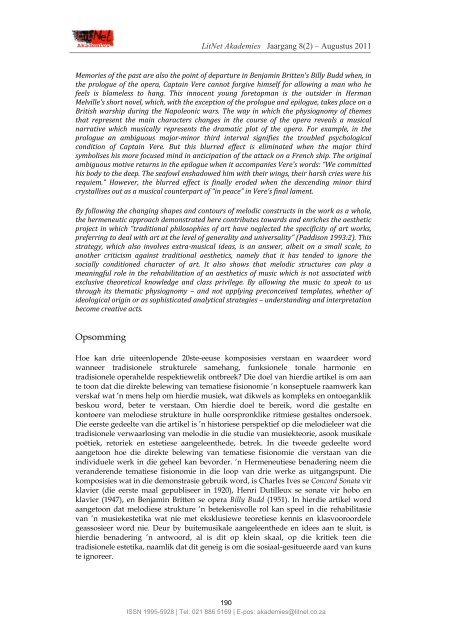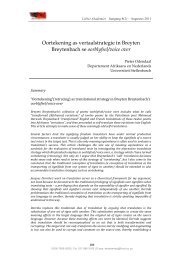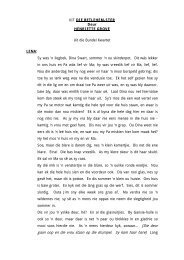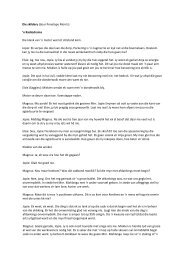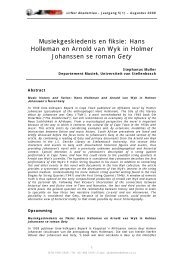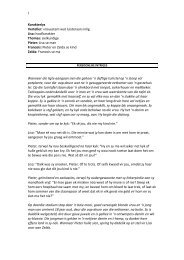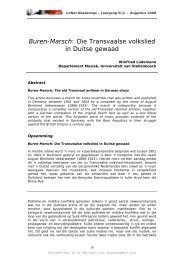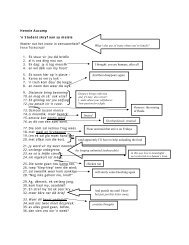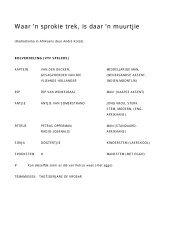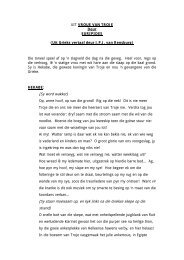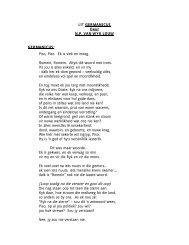Jaargang 8, nommer 2 – Augustus 2011 - LitNet
Jaargang 8, nommer 2 – Augustus 2011 - LitNet
Jaargang 8, nommer 2 – Augustus 2011 - LitNet
Create successful ePaper yourself
Turn your PDF publications into a flip-book with our unique Google optimized e-Paper software.
<strong>LitNet</strong> Akademies <strong>Jaargang</strong> 8(2) <strong>–</strong> <strong>Augustus</strong> <strong>2011</strong><br />
Memories of the past are also the point of departure in Benjamin Britten's Billy Budd when, in<br />
the prologue of the opera, Captain Vere cannot forgive himself for allowing a man who he<br />
feels is blameless to hang. This innocent young foretopman is the outsider in Herman<br />
Melville's short novel, which, with the exception of the prologue and epilogue, takes place on a<br />
British warship during the Napoleonic wars. The way in which the physiognomy of themes<br />
that represent the main characters changes in the course of the opera reveals a musical<br />
narrative which musically represents the dramatic plot of the opera. For example, in the<br />
prologue an ambiguous major‐minor third interval signifies the troubled psychological<br />
condition of Captain Vere. But this blurred effect is eliminated when the major third<br />
symbolises his more focused mind in anticipation of the attack on a French ship. The original<br />
ambiguous motive returns in the epilogue when it accompanies Vere's words: “We committed<br />
his body to the deep. The seafowl enshadowed him with their wings, their harsh cries were his<br />
requiem.” However, the blurred effect is finally eroded when the descending minor third<br />
crystallises out as a musical counterpart of “in peace” in Vere's final lament.<br />
By following the changing shapes and contours of melodic constructs in the work as a whole,<br />
the hermeneutic approach demonstrated here contributes towards and enriches the aesthetic<br />
project in which “traditional philosophies of art have neglected the specificity of art works,<br />
preferring to deal with art at the level of generality and universality” (Paddison 1993:2). This<br />
strategy, which also involves extra‐musical ideas, is an answer, albeit on a small scale, to<br />
another criticism against traditional aesthetics, namely that it has tended to ignore the<br />
socially conditioned character of art. It also shows that melodic structures can play a<br />
meaningful role in the rehabilitation of an aesthetics of music which is not associated with<br />
exclusive theoretical knowledge and class privilege. By allowing the music to speak to us<br />
through its thematic physiognomy <strong>–</strong> and not applying preconceived templates, whether of<br />
ideological origin or as sophisticated analytical strategies <strong>–</strong> understanding and interpretation<br />
become creative acts.<br />
Opsomming<br />
Hoe kan drie uiteenlopende 20ste-eeuse komposisies verstaan en waardeer word<br />
wanneer tradisionele strukturele samehang, funksionele tonale harmonie en<br />
tradisionele operahelde respektiewelik ontbreek? Die doel van hierdie artikel is om aan<br />
te toon dat die direkte belewing van tematiese fisionomie ’n konseptuele raamwerk kan<br />
verskaf wat ’n mens help om hierdie musiek, wat dikwels as kompleks en ontoeganklik<br />
beskou word, beter te verstaan. Om hierdie doel te bereik, word die gestalte en<br />
kontoere van melodiese strukture in hulle oorspronklike ritmiese gestaltes ondersoek.<br />
Die eerste gedeelte van die artikel is ’n historiese perspektief op die melodieleer wat die<br />
tradisionele verwaarlosing van melodie in die studie van musiekteorie, asook musikale<br />
poëtiek, retoriek en estetiese aangeleenthede, betrek. In die tweede gedeelte word<br />
aangetoon hoe die direkte belewing van tematiese fisionomie die verstaan van die<br />
individuele werk in die geheel kan bevorder. ’n Hermeneutiese benadering neem die<br />
veranderende tematiese fisionomie in die loop van drie werke as uitgangspunt. Die<br />
komposisies wat in die demonstrasie gebruik word, is Charles Ives se Concord Sonata vir<br />
klavier (die eerste maal gepubliseer in 1920), Henri Dutilleux se sonate vir hobo en<br />
klavier (1947), en Benjamin Britten se opera Billy Budd (1951). In hierdie artikel word<br />
aangetoon dat melodiese strukture ’n betekenisvolle rol kan speel in die rehabilitasie<br />
van ’n musiekestetika wat nie met eksklusiewe teoretiese kennis en klasvooroordele<br />
geassosieer word nie. Deur by buitemusikale aangeleenthede en idees aan te sluit, is<br />
hierdie benadering ’n antwoord, al is dit op klein skaal, op die kritiek teen die<br />
tradisionele estetika, naamlik dat dit geneig is om die sosiaal-gesitueerde aard van kuns<br />
te ignoreer.<br />
190<br />
ISSN 1995-5928 | Tel: 021 886 5169 | E-pos: akademies@litnet.co.za


